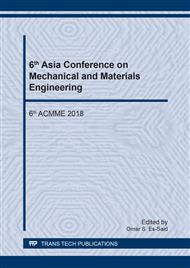[1]
P. R. Li, J. C. Wei, Y. F. Chiu, H. L. Su, F. C. Peng, and J. J. Lin, Evaluation on cytotoxicity and genotoxicity of the exfoliated silicate nanoclay,, ACS Appl. Mater. Interfaces, vol. 2, no. 6, p.1608–1613, (2010).
DOI: 10.1021/am1001162
Google Scholar
[2]
S. Maisanaba, M. Puerto, S. Pichardo, M. Jordá, F. J. Moreno, S. Aucejo, and Á. Jos, In vitro toxicological assessment of clays for their use in food packaging applications,, Food Chem. Toxicol., vol. 57, p.266–275, (2013).
DOI: 10.1016/j.fct.2013.03.043
Google Scholar
[3]
D. Van Berlo, P. Haberzettl, K. Gerloff, H. Li, A. M. Scherbart, C. Albrecht, and R. P. F. Schins, Investigation of the Cytotoxic and Proinflammatory Effects of Cement Dusts in Rat Alveolar Macrophages,, p.1548–1558, (2009).
DOI: 10.1021/tx900046x
Google Scholar
[4]
S. Sinha Ray and M. Okamoto, Polymer/layered silicate nanocomposites: A review from preparation to processing,, Prog. Polym. Sci., vol. 28, no. 11, p.1539–1641, (2003).
DOI: 10.1016/j.progpolymsci.2003.08.002
Google Scholar
[5]
M. Jorda-Beneyto, N. Ortuño, a Devis, S. Aucejo, M. Puerto, D. Gutiérrez-Praena, J. Houtman, S. Pichardo, S. Maisanaba, and a Jos, Use of nanoclay platelets in food packaging materials: technical and cytotoxicity approach.,, Food Addit. Contam. Part A. Chem. Anal. Control. Expo. Risk Assess., vol. 31, no. 3, p.354–63, (2014).
DOI: 10.1080/19440049.2013.874045
Google Scholar
[6]
J. Gormley, I P, Addison, The In Vitro Cytotoxicity of Some Standard Clay Mineral Dusts of Respirable Size,, Clay Miner., vol. 18, pp.153-163, (1983).
DOI: 10.1180/claymin.1983.018.2.04
Google Scholar
[7]
E. J. Murphy, E. Roberts, and L. A. Horrocks, SILICATE TOXICITY IN CELL CULTURES,, vol. 55, no. 2, p.597–605, (1993).
DOI: 10.1016/0306-4522(93)90527-m
Google Scholar
[8]
H. J, M. S, P. M, G.-P. D, J. M, A. S, and J. A, Toxicity assessment of organomodified clays used in food contact materials on human target cell lines,, Appl. Clay Sci., vol. 90, p.150–158, (2014).
DOI: 10.1016/j.clay.2014.01.009
Google Scholar
[9]
S. Maisanaba, D. Gutiérrez-Praena, S. Pichardo, F. J. Moreno, M. Jordá, A. M. Cameán, S. Aucejo, and A. Jos, Toxic effects of a modified montmorillonite clay on the human intestinal cell line Caco-2.,, J. Appl. Toxicol., vol. 34, no. 6, p.714–25, (2014).
DOI: 10.1002/jat.2945
Google Scholar
[10]
S. Lordan, E. Kennedy, and C. L. Higginbotham, Cytotoxic effects induced by unmodified and organically modified nanoclays in the human hepatic HepG2 cell line,, no. November 2009, p.27–35, (2011).
DOI: 10.1002/jat.1564
Google Scholar
[11]
K. S. Katti, A. H. Ambre, N. Peterka, and D. R. Katti, Use of unnatural amino acids for design of novel organomodified clays as components of nanocomposite biomaterials.,, Philos. Trans. A. Math. Phys. Eng. Sci., vol. 368, no. 1917, p.1963–1980, (2010).
DOI: 10.1098/rsta.2010.0008
Google Scholar
[12]
F. Wang, Cancer Cell Culture—Methods and Protocols,, Vitr. Cell. Dev. Biol. - Anim., vol. 39, no. 10, p.476, (2003).
Google Scholar
[13]
K. Popov, A. Kolosov, Y. Ermakov, V. Yachmenev, A. Yusipovich, N. Shabanova, B. Kogut, and A. Frid, Enhancement of clay zeta-potential by chelating agents,, Colloids Surfaces A Physicochem. Eng. Asp., vol. 244, no. 1–3, p.25–29, (2004).
DOI: 10.1016/j.colsurfa.2004.06.015
Google Scholar
[14]
S. I. Marras, A. Tsimpliaraki, I. Zuburtikudis, and C. Panayiotou, Thermal and colloidal behavior of amine-treated clays: The role of amphiphilic organic cation concentration,, Journal of Colloid and Interface Science, vol. 315, p.520–527, (2007).
DOI: 10.1016/j.jcis.2007.06.023
Google Scholar
[15]
E. T. and M. Szekeres, Colloidal behavior of aqueous montmorillonite suspensions : the specific role of pH in the presence of indifferent electrolytes,, Appl. Clay Sci., vol. 27, p.75–94, (2004).
DOI: 10.1016/j.clay.2004.01.001
Google Scholar
[16]
H. Liu, P. Yuan, D. Liu, D. Tan, H. He, and J. Zhu, Effects of solid acidity of clay minerals on the thermal decomposition of 12-aminolauric acid,, J. Therm. Anal. Calorim., vol. 114, no. 1, p.125–130, (2013).
DOI: 10.1007/s10973-012-2887-0
Google Scholar
[17]
D. Zadaka, A. Radian, and Y. G. Mishael, Applying zeta potential measurements to characterize the adsorption on montmorillonite of organic cations as monomers, micelles, or polymers,, J. Colloid Interface Sci., vol. 352, no. 1, p.171–177, (2010).
DOI: 10.1016/j.jcis.2010.08.010
Google Scholar
[18]
H. Bouwmeester, S. Dekkers, M. Y. Noordam, W. I. Hagens, A. S. Bulder, C. de Heer, S. E. C. G. ten Voorde, S. W. P. Wijnhoven, H. J. P. Marvin, and A. J. A. M. Sips, Review of health safety aspects of nanotechnologies in food production,, Regul. Toxicol. Pharmacol., vol. 53, no. 1, p.52–62, (2009).
DOI: 10.1016/j.yrtph.2008.10.008
Google Scholar
[19]
C. Silvestre, D. Duraccio, and S. Cimmino, Food packaging based on polymer nanomaterials,, Prog. Polym. Sci., vol. 36, no. 12, p.1766–1782, (2011).
DOI: 10.1016/j.progpolymsci.2011.02.003
Google Scholar


